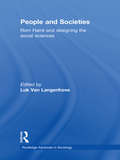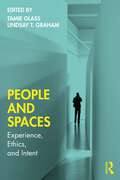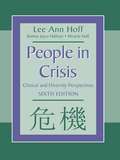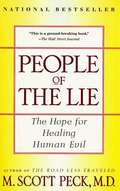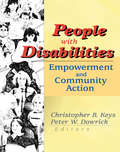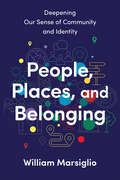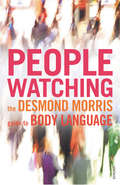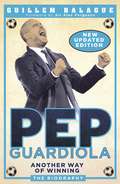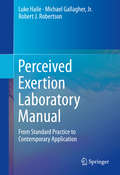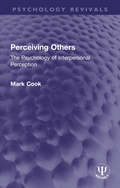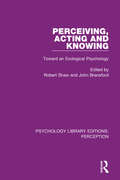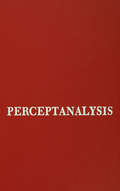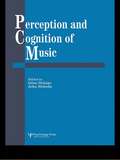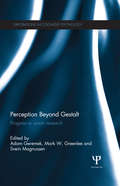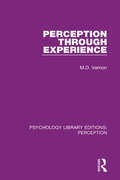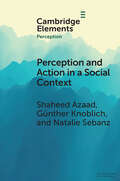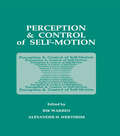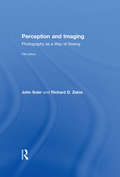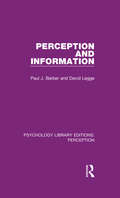- Table View
- List View
People and Societies: Rom Harré and Designing the Social Sciences (Routledge Advances in Sociology)
by Luk Van LangenhoveRom Harré has pushed the boundaries of our thinking about people and societies and has challenged the orthodox philosophy of science and social psychology. His countless books and articles have inspired generations of scholars in philosophy, psychology, linguistics, cognitive science and social theory. The diversity of his work makes that some see him as a leading figure in the critical realist school of philosophy of science, other as a key player in developing a social constructionist approach to psychology. The present volume brings together a careful selection of his key writings and presents them in a framework that stresses the evolution of his thinking as well as the place of his thinking in ongoing debates in different disciplines. The overall theme is the study of people and their ways of life. This is the first book that gives readers a systematic introduction in the conceptual universe of this towering figure.
People and Spaces: Experiences, Ethics, and Intent
by Tamie Glass Lindsay T. GrahamPeople and Spaces: Experience, Ethics, and Intent examines the dynamic relationship between built environments and human behavior in today's rapidly evolving world.Co-edited by a designer and a psychologist, this interdisciplinary collection reveals how the spaces we inhabit shape and reflect our self-expression, social structures and cultural values. Drawing on diverse perspectives, case studies and innovative research, People and Spaces equips readers from any discipline with practical human-centric knowledge to enhance environments in meaningful ways. This blend of essays and expert insights demonstrates the value of intentional approaches to design and research and offers actionable guidance for creating supportive and sustainable environments.This book is relevant to a broad audience, including scholars, professionals, and students in architecture, interior design, psychology, and related fields, as well as industry practitioners interested in the intersection of built environments and human experience. It is an essential resource for those seeking to understand and influence the dynamic relationship between people and space.
People in Crisis: Clinical and Diversity Perspectives
by Lisa Brown Lee Ann Hoff Miracle R. HoffThe first edition of People in Crisis, published in 1978, established success as a comprehensive and user-friendly text for health and social service professionals. The book and its following incarnations included critical life events and life cycle transition challenges, clearly pointing out the interconnections between such events, stressful developmental changes, and their potential for growth but also danger of suicide and/or violence toward others. This revised edition includes new case examples and expanded coverage of cross-cultural content, including 'commonalities and differences' in origins, manifestations, and crisis responses. The authors illustrate the application of crisis concepts, assessment, and intervention strategies across a wide range of health and mental health settings, as well as at home, school, workplace, and in the community. Each chapter contains a closing summary that includes discussion questions, references, and online data sources for maximum application and learning. Updated chapters discuss new, research-based content on: • workplace violence and abuse• youth violence in schools and higher education settings• the use of psychotropic drugs, including for very young children in the absence of comprehensive assessment• the crisis vulnerability of war veterans and the hazards of 'pathologizing' what should be considered a 'normal' response to the repeated and catastrophic trauma of war• the intersection of socio-political factors with individuals’ psychological healing from catastrophic experiences such as war and natural disaster.
People of the Lie: The Hope for Healing Human Evil
by M. Scott Peck<p>In this absorbing and equally inspiring companion volume to his classic trilogy—The Road Less Traveled, Further Along the Road Less Traveled, and The Road Less Traveled and Beyond—Dr. M. Scott Peck brilliantly probes into the essence of human evil. <p>People who are evil attack others instead of facing their own failures. Peck demonstrates the havoc these people of the lie work in the lives of those around them. He presents, from vivid incidents encountered in his psychiatric practice, examples of evil in everyday life. <p>This book is by turns disturbing, fascinating, and altogether impossible to put down as it offers a strikingly original approach to the age-old problem of human evil.</p>
People with Disabilities: Empowerment and Community Action
by Peter W. Dowrick Christopher B. KeysDevelop more effective community initiatives and build solid collaborations!Although the fields of disability studies and community psychology developed separately, with little crossover, they have evolved similar values, principles, and tactics. People with Disabilities: Empowerment and Community Action is the first volume to bring together these two fields. Now disability activists and community psychologists can join forces, share ideas, and gain strength from one another.This landmark volume offers empirical research and practical advice from respected scholars in the field. People with Disabilities: Empowerment and Community Action presents tested strategies for empowering a wide variety of people with disabilities, including Latinos, the aged, the developmentally disabled, low-income schoolchildren, and patients with chronic diseases. The diversity of strategies offered here means that every community can find a way to make its own voice heard.People with Disabilities: Empowerment and Community Action offers detailed, step-by-step plans for developing a broad range of programs, including: choosing strategies to suit rural, suburban, and urban environments taking a capacity-building approach to community empowerment developing participatory action plans building effective coalitions enabling collaboration between inner-city universities and the community With its solid research, helpful tables and figures, and well-organized action plans, this book is certain to become a classic in the fields of disability studies and community psychology.
People, Not Psychiatry (Routledge Library Editions: Psychiatry #2)
by Michael BarnettOriginally published in 1973, this book is about people and psychiatry. About people who rejected psychiatry as it was generally practised at the time, people who sought for and found alternative ways of caring for and healing one another. The author, who had been active in radical alternatives to psychiatry for some time, offers us a programme based not on drugs, repression and a ‘questionable’ expertise, but on human caring, greater awareness of the body, deeper communication between persons and a willingness to let the emotions flow. It is a challenging alternative which came at a time when the viability of scientific, theoretical and chemical approaches to distress were being questioned at all levels of society. This alternative includes the new direct methods of healing (making whole) such as Encounter, Gestalt, Bioenergetics, Psychofantasy – methods that do not do things to people but allow them to feel their way into change through experiment, flow and choice. The main focus of the book is People, not Psychiatry (PNP), the network set up by the author in 1969. PNP is open to all, and people in it help one another in times of stress and crisis, if they are asked to and when they are needed. One of the main assets of these networks is that they are an alternative and they are there. The book tells the story of PNP’s birth and growth. It is a personal story, a moving story, a story about people. In addition, the book contains some lively theoretical discussion, both simple and clear, in the course of which the author tentatively offers his own theory of neurosis – that many people become victims of the primitive logic patterns laid down in infancy, patterns that become reinforced through fear and habit and have to be dissolved or replaced if we are to enjoy a full, healthy, free-flowing life. The book is directed at doctors, patients, consultants, nurses, psychologists, social workers, therapists, in fact anyone involved in any way in the field of psychiatry. It is also offered to all those whom psychiatry touches, that it to say – everyone.
People, Places, and Belonging: Deepening Our Sense of Community and Identity
by William MarsiglioPlace matters – for good and bad. Infinitely diverse in form, place embodies the action settings where social life happens. Often fighting to preserve a sense of group belonging in the process, we design places to reflect our values and interests. With an eye on our rapidly changing world, People, Places, and Belonging explores how social realities at every level are affected by the places we collectively forge across various social domains. The book shows how place-related circumstances can promote personal empowerment, civic engagement, and social and environmental justice. Discussing places that affect personal and social well-being, including homes, communities, vehicles, and the metaverse, William Marsiglio illustrates how a web of social processes involving claims, attachments, rituals, and transitions (CART) structure our experiences in place. The author argues that we can use decision-making principles to enhance our attachments, encourage supportive rituals, smooth out transitions, and manage claims with less conflict and more social justice. Armed with a heightened place consciousness and ethical principles, People, Places, and Belonging ultimately posits that we must individually and collectively build places that enrich our lives, celebrate the communal spirit, and foster social equity and ecological justice.
People-Reading: How We Control Others, How They Control Us
by Ernst G. Beier Evans G. ValensOf the many books designed to help with the understanding of one's behavior, People-Reading is in a class by itself. It provides specific guidelines on how to "read" people as well as how to "read" oneself. It is an easy to read book that is based on sound scientific principles, illustrated with many well-selected cases from Dr. Beier's own work as a psychotherapist.
Peoplemaking
by Virginia SatirAll of the ingredients in a family that count are changeable and correctable - individual self-worth, communication, system, and rules - at any point in time. Any piece of behavior, at a moment in time, is the outcome of the four-way interplay of the person's self-worth and body condition of that moment, his interaction with another, his system, and his place in time and space and situation. To explain his behavior, something needs to be said about all these facts, not just one, and then consider how each part influences the other.
Peoplewatching: The Desmond Morris Guide to Body Language
by Desmond MorrisPeoplewatching is the culmination of a career of watching people - their behaviour and habits, their personalities and their quirks. Desmond Morris shows us how people, consciously and unconsciously, signal their attitudes, desires and innermost feelings with their bodies and actions, often more powerfully than with their words.
Pep Guardiola: Another Way of Winning: The Biography
by Guillem Balague'A must-read for anyone who's doubted Pep's influence, from handing the power to Barça's homegrown crop to never betraying his childhood romanticism of the game Four Four Two'Balague's insightful biography presents Guardiola as a relentless perfectionist - a man obsessed with the minutiae of football, often unable to switch off' SPORTThis fully updated edition of the international bestseller includes Manchester City's incredible 2017-18 league triumphPep Guardiola is the most successful and sought-after football coach in the world. After being appointed first-team manager in 2008, he transformed Barcelona into arguably the greatest club side of all time, winning thirteen trophies in four years, and he won the Double twice in his three years in charge of Bayern Munich. He then faced his biggest challenge yet when he joined Manchester City in 2016: to turn them into a team that consistently wins in the most difficult of leagues and a regular challenger in the Champions League. But in only his second year at the club, he had turned a good side into memorable one, leading them to the Premier League title in record-breaking style . . . and doing it the Guardiola way.Guillem Balagué has followed Pep's career from the outset and has had direct access to the man and his inner circle for this updated edition. This then is the definitive portrait of Pep Guardiola and his relentless pursuit of footballing perfection.
Perceived Exertion Laboratory Manual
by Michael Gallagher Jr. Luke Haile Robert J. Robertson This manual provides laboratory-based learning experiences in perceptually and psychosocially linked exercise assessment, prescription, and programming. The primary pedagogic outcome is the ability to use applied theory and practice in perceptual and psychosocial exercise assessment and program design to promote the adoption and maintenance of a physically active lifestyle, enhancing overall health fitness. Perceptual and psychosocial variables are presented in individual, stand-alone laboratory modules that can supplement existing curricula such as exercise and sport psychology, exercise physiology, exercise testing and prescription, and exercise training and conditioning. In addition, the complete modular set has a conceptual flow that allows its presentation as an entire, laboratory-based course. The laboratory modules are divided into three primary units: assessment (theoretical constructs, scales and procedures, tests), prescription (self-regulation, performance), and program evaluation. The manual uses a unique format in which case studies are embedded in the conceptual flow of each lab module facilitating translation of laboratory results to real-world application. The manual concludes with a discussion of perceptually and psychosocially linked exercise prescription and programming applications in public health, such as program monitoring and adherence.
Perceiving Events and Objects
by William Epstein Gunnar Jansson Sten Sture BergströmBeginning with his doctoral dissertation in 1950 which introduced the study of event perception and the application of vector analysis to perception, Gunnar Johansson has been a seminal figure in the field of perception. His work on biomechanical motion in the 1970s challenged conventional notions and stimulated great interest among experimental psychologists and students of machine vision. In 1989 Johansson published his latest theoretical synthesis, the optic sphere theory, an innovative conceptualization that goes beyond his earlier proposals. This volume presents -- for the first time -- an extensive precis of the out-of-print classic 1950 monograph prepared by Johansson. It also includes a representative set of Johansson's important publications produced over the ensuing four decades. These papers served as the springboard for a set of original essays by a distinguished group of North American and European scientists. Part critical commentary, part elaboration, and part seeking new directions, the entire collection makes for a singularly rich treatment of the perception of objects and events.
Perceiving Others: The Psychology of Interpersonal Perception (Psychology Revivals)
by Mark CookOriginally published in 1979, Perceiving Others is an excellent, short introduction to the area of social psychology known as ‘person perception’, ‘social perception’ or ‘impression formation’ – how people interpret each others’ moods, predict each others’ behaviour and sum up each others’ characters. The way people see each other determines the way they behave towards each other making the study of ‘person perception’ essential to the understanding of social behaviour. Mark Cook poses three questions about how people form opinions of others: what are the processes involved, what information is used and how, and how accurate are they? He provides an answer to these questions in the three main sections of the book, giving a comprehensive survey of the theory and research arising from the issues involved. The topics covered include the meaning of trait descriptions, intuition, social skill and non-verbal communication, the impression formation paradigm, stereotypes, implicit personality theories, attribution theory, Cronbach’s components and psychiatric diagnosis. By drawing many of his illustrations from everyday encounters, the author effectively bridges the gap between theory and reality to create a thoroughly readable and comprehensible study.
Perceiving the Affordances: A Portrait of Two Psychologists
by Eleanor J. GibsonPerceiving the Affordances is a personal history and intellectual autobiography of Eleanor Gibson, the groundbreaking research psychologist who was influential in the founding of the theory of perceptual development. It is also a biography of her husband, James J. Gibson, who was a major perceptual theorist and the founder of the ecologically-oriented theory of perception. This is the story of their lives together and how each came to make particular contributions. This book is of interest to people who study perception, perceptual development, infancy, developmental psychology, and the history of psychology.
Perceiving the Divine through the Human Body
by Thomas Cattoi June McdanielCattoi and McDaniel present a selection of articles on the role of the body and the spiritual senses - our transfigured channels of sensory perceptions - in the context of spiritual practice. The volume investigates this theme across a variety of different religious traditions within Christianity, Hinduism, Buddhism, and Daoism.
Perceiving, Acting and Knowing: Toward an Ecological Psychology (Psychology Library Editions: Perception #27)
by Robert Shaw and John BransfordOriginally published in 1977, the chapters in this volume derive from a conference on Perceiving, Acting and Knowing held by the Center for Research in Human Learning at the University of Minnesota in 1973. The volume was intended to appeal, not just to the specialist or the novice, but to anyone sufficiently interested in psychology to have obtained a sense of its history at the time. Through these essays the authors express a collective attitude that a careful scrutiny of the fundamental tenets of contemporary psychology may be needed. In some essays specific faults in the foundations of an area are discussed, and suggestions are made for remedying them. In other essays the authors flirt with more radical solutions, namely, beginning from new foundations altogether. Although the authors do not present a monolithic viewpoint, a careful reading of all their essays under one cover reveals a glimpse of a new framework by which theory and research may be guided.
Perceptanalysis: The Rorschach Method Fundamentally Reworked, Expanded and Systematized
by Z. A. PiotrowskiFirst Published in 1987. Routledge is an imprint of Taylor & Francis, an informa company.
Perception And Cognition Of Music
by Irène Deliège John SlobodaThis text comprises of reviews of work relating to music and mind. It presents a range of approaches from the psychological through the computational, to the musicological. The reviews were selected from papers submitted at the Third International Conference on Music Perception and Cognition Liege 1994 to illustrate the wide range of perspectives now being adopted in studying how humans make and respond to music. The book is divided ino five sections. The first part illustrates the role of analysis and ethnomusicology in understanding cultural determinants of musical behaviour. The second part charts what is known about aquisition of musical competence, from pre-birth through to the expert performer. The evidence accumulated about specific areas of the brain which control musical thinking and behaviour is examined in Part Three. The fourth part examines how neurological, behavioural and artificial intelligence approaches are converging to shed light on processes in auditory perception. Finally, Part Five highlights the important developments in how we conceptualize the way in which musical structures are represented in the mind.
Perception Beyond Gestalt: Progress in vision research (Explorations in Cognitive Psychology)
by Adam Geremek Mark W. Greenlee Svein MagnussenHow does the brain piece together the information required to achieve object recognition, figure-ground segmentation, object completion in cases of partial occlusion and related perceptual phenomena? This book focuses on principles of Gestalt psychology and the key issues which surround them, providing an up-to-date survey of the most interesting and highly debated topics in visual neuroscience, perception and object recognition. The volume is divided into three main parts: Gestalt and perceptual organisation, attention aftereffects and illusions, and color vision and art perception. Themes covered in the book include: - a historical review of Gestalt theory and its relevance in modern-day neuroscience- the relationship between perceptive and receptive fields- a critical analysis of spatiotemporal unity of perception- the role of Gestalt principles in perceptual organization- self-organizing properties of the visual field- the role of attention and perceptual grouping in forming non-retinotopic representations- figural distortions following adaptation to spatial patterns- illusory changes of brightness in spatial patterns- the function of motion illusions as a tool to study Gestalt principles in vision- conflicting theories of color vision and the neural basis of it- the role of color in figure-ground segmentation- chromatic assimilation in visual art and perception- the phenomena of colored shadows.Including contributions from experts in the field, this book will provide an essential overview of current research and theory on visual perception and Gestalt. It will be key reading for researchers and academics in the field of visual perception and neuroscience.
Perception Through Experience (Psychology Library Editions: Perception #30)
by M.D. VernonThe term ‘visual perception’ covers a very wide range of psychological functions. This title, originally published in 1970, which provides a broad survey of this vast field of knowledge, would have proved a valuable general account for students taking degree courses in psychology at the time. Professor Vernon examines a large number of experiments carried out over the previous twenty years, their findings, the conclusions drawn from them, and – equally important – the still unanswered questions which some of them raised. As the title suggests, Professor Vernon considers that – while much knowledge of the simpler perceptual processes had been gained in laboratory experiments – perhaps too little investigation had been undertaken into the more complex processes which normally determine understanding of and response to environment: the processes of identification and classification that depend to a considerable extent on learning, memory, attention, reasoning and language. An extensive bibliography is provided.
Perception and Action in a Social Context (Elements in Perception)
by Shaheed Azaad Günther Knoblich Natalie SebanzEven the simplest social interactions require us to gather, integrate, and act upon, multiple streams of information about others and our surroundings. In this Element, we discuss how perceptual processes provide us with an accurate account of action-relevant information in social contexts. We overview contemporary theories and research that explores how: (1) individuals perceive others' mental states and actions, (2) individuals perceive affordances for themselves, others, and the dyad, and (3) how social contexts guide our attention to modulate what we perceive. Finally, we review work on the cognitive mechanisms that make joint action possible and discuss their links to perception.
Perception and Control of Self-motion (Resources for Ecological Psychology Series)
by Rik Warren Alexander H. WertheimThis book presents studies of self-motion by an international group of basic and applied researchers including biologists, psychologists, comparative physiologists, kinesiologists, aerospace and control engineers, physicians, and physicists. Academia is well represented and accounts for most of the applied research offered. Basic theoretical research is further represented by private research companies and also by government laboratories on both sides of the Atlantic. Researchers and students of biology, psychology, physiology, kinesiology, engineering, and physics who have an interest in self-motion -- whether it be underwater, in space, or on solid ground -- will find this volume of interest. This book presents studies of self-motion by an international group of basic and applied researchers including biologists, psychologists, comparative physiologists, kinesiologists, aerospace and control engineers, physicians, and physicists. Academia is well represented and accounts for most of the applied research offered. Basic theoretical research is further represented by private research companies and also by government laboratories on both sides of the Atlantic. Researchers and students of biology, psychology, physiology, kinesiology, engineering, and physics who have an interest in self-motion -- whether it be underwater, in space, or on solid ground -- will find this volume of interest.
Perception and Imaging: Photography as a Way of Seeing
by John Suler Richard D. ZakiaWhen you look at an image, what do you see and feel? What do you want your audience to see and feel when they view your work? For over thirty years, Dr. Richard Zakia helped thousands of photographers hone in on their creative vision through the inspirational, informative text and images included in his classic book, Perception and Imaging. More than a step-by-step photography instruction manual, Perception and Imaging explores the fundamental act of photography – seeing – through a uniquely comprehensive combination of technique, history, visual perception, philosophy and psychology. No matter your level of technical skill, you can learn to think more clearly about what you wish to convey in your images. Fully revised to account for the unique influences and consequences of the digital revolution and online photosharing, John Suler newly addresses digital impermanence, sensory and cognitive overload, and the selfie, and their effects on perception. Additional coverage also includes microexpressions, Rorschach inkblots and subliminal reactions, transference, and synectics.
Perception and Information (Psychology Library Editions: Perception #1)
by Paul J. Barber David LeggePerception is about the reception, selection, acquisition, transformation and organization of sensory information. This book, originally published in 1976, discusses a number of aspects of human perception within a theoretical framework in which man is considered as a processor of information. The main emphasis is on visual perception with particular reference to looking and pattern recognition; selective listening and speech recognition are also discussed.
